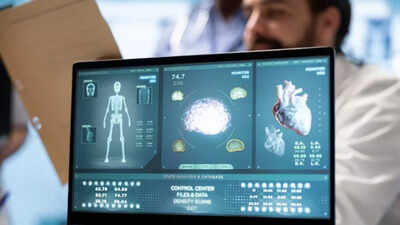ARTICLE AD BOX

Imagine an AI that can look at your medical history, lifestyle, and age – and tell you what diseases you might get in the next decade or even longer. That’s no longer just science fiction.A team of European scientists has built a tool that predicts the risk of more than 1,000 diseases, up to 20 years ahead!What’s more? It’s been trained on massive health databases in the United Kingdom and Denmark, and it uses patterns in people’s past diagnoses, habits, and lifestyles to forecast what might come.Intrigued yet? Read on to know more.
What Is This New AI Tool?
The AI model that’s being hailed as a revolutionary tool in medical science and technological innovation is named Delphi-2M.
It was built by scientists from the European Molecular Biology Laboratory (EMBL), the German Cancer Research Centre (DKFZ), and the University of Copenhagen. Delphi-2M is a generative AI tool – similar in idea to large language models – except instead of predicting words, it predicts health outcomes.It uses anonymized patient data: about 400,000 people from the UK Biobank and 1.9 million records from Denmark’s national patient registry.
That big data helps it learn how diseases tend to develop over time in different people.While it’s not yet available in a doctor’s office, it marks a big shift toward predictive, personalized health care.
How it works
Generative AI architecture: Similar to large language models (LLMs), which generate text, but adapted to health data. It sees patterns of how medical events (diseases being diagnosed, lifestyle changes, etc.) unfold over time.Timeline and sequences: It looks not only at what medical events happened, but when they happened, and in what order. For example: whether someone smoked, got a diagnosis, changed habits, etc., plus how long between those events. This helps the model see risk trajectories.Expresses risk as probabilities: It doesn’t say “you will get disease X” but “you have X% risk over Y years.” That’s like forecasting weather: you might get rain, or you might not, but you know how likely it is.
What it can do
The AI model Delphi-2M is good with diseases that have consistent, predictable progression. Chronic diseases like heart disease, diabetes, some cancers, septicaemia (blood poisoning), etc, can be detected beforehand with the help of this tool. Because these often follow patterns, the tool tends to predict them more accurately.Useful for early warning: It can identify the high risk well in advance, which means interventions (lifestyle changes, monitoring, possibly early treatment) might help reduce or delay the disease.Population health and planning: The tool could help healthcare systems plan for future disease burden, allocate resources, and design preventive programs.
Why it matters
As the generative AI tool enables early warning – for people whose lifestyles or medical history put them at higher risk – it could help doctors spot danger earlier, perhaps years before symptoms emerge. That could mean preventive steps, monitoring, and lifestyle changes.Personalized prevention: Instead of a one-size-fits-all approach, health care could become more tailored. For example, someone might be told to focus on blood sugar management, weight control, or diet changes based on their specific disease risk profile.Healthcare planning: With aging populations and rising chronic diseases, predicting who is likely to develop which conditions could help health systems manage resources better (e.g.,
screening, preventive care) and anticipate demands.
Limitations of the AI tool
Although the AI tool has shown promise, the model isn’t yet approved for use in everyday doctors’ offices. More validation, regulatory approval, and testing are needed. It’s also less reliable for some disease types. Diseases with unpredictable onset – such as many infectious diseases, many mental health disorders, or rare diseases – are harder for the AI to predict accurately.
The variability, lack of pattern, or influence of unrecorded events makes predictions weaker. There’s also the matter of bias and representation issues. Training data came primarily from UK and Danish health records. That means some ethnic groups, age groups, or regions are underrepresented. The model may not perform equally well in populations very different from those used in its training. Finally, what this AI tool predicts is mostly probabilistic – not certain or set in stone. Just because the model gives a high risk doesn't mean a person will get the disease. It means the risk is elevated. Similarly, low risk doesn’t guarantee safety. Decisions based on it must be made carefully, ideally in consultation with a medical professional.
Google’s New AI Is BANANAS: How To Use Gemini Nano Banana



.png)
.png)
.png)
















 1 hour ago
3
1 hour ago
3










 English (US) ·
English (US) ·